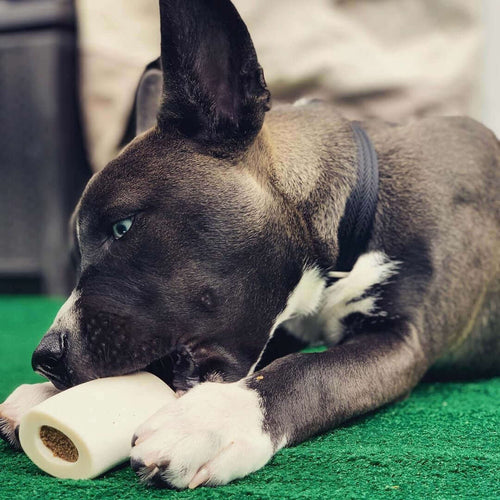
5 Common Cat Diseases and How to Prevent Them
Share
Cold weather is approaching, and your fur babies are sneezing, coughing, and has a runny nose! You start to wonder if your cat caught that cold going around the office. But, what if it’s something more serious?
For most cat parents, the idea of their fur baby getting sick is nearly unimaginable. No one wants to imagine their cat(s) falling ill or contracting a serious disease, but the fact is, our world exposes cats to a wide range of risk factors.
Cats are notorious for being strong and resilient. Most of the time, pet parents won’t even realize their cat is sick or coming down with an illness. However, our lack of noticing does not mean it’s not happening.
That’s why it’s essential to educate yourself on common cat diseases so you’re able to recognize the signs and symptoms, and arguably more important, find ways to prevent your cat(s) from contracting any disease to begin with.
We’ve compiled a list for you to learn about the five most common cat diseases, their symptoms, and how to best protect your cats!
5 Common Cat Diseases
Diabetes or (also called Mellitus)
A healthy cat should be able to break food down into many different components, including glucose. Glucose is carried to cells by insulin, and when a cat’s body does not produce insulin or cannot use it normally, their blood sugar levels may increase. According to the ASPCA, the result is hyperglycemia, which, if left untreated, can cause many complicated health problems for a cat.
Feline Diabetes is an increasingly common disease for domesticated cats. This condition often occurs in cats who are overweight or mature. Cats with Type II Diabetes may need different types of treatment, and it can progress to Type I Diabetes. Cats with Type I Diabetes will require insulin therapy to survive.

Common Symptoms of Diabetes (Mellitus) in Cats:
- Change in appetite (either increased or decreased)
- Weight loss
- Excessive thirst/increase in water consumption
- Increased urination
- Urinating in areas other than litter box
- Unusually sweet-smelling breath
- Lethargic behavior
- Unkempt haircoat
- Repeated urinary tract infections
Preventing Diabetes in Cats
Preventing insulin resistance will help lower your cat’s risk of diabetes. Generally, this means feeding your cat a canned food that is low in carbs, easily digestible and high in protein. It’s also always important to supply your cat with plenty of fresh drinking water with and in-between every meal.
In addition to doing your part at home, annual or bi-annual check-ups are the best way to stay on top of your cat’s health needs.
Chronic Kidney Disease
Chronic Kidney Disease (CKD) is described as the loss of kidney function over time. The kidneys act as a filter for the blood, removing waste and bacteria. The waste is then excreted through your cat’s urine.
Did you know? 1 in 3 cats or more will develop some form of kidney disease in their lifetime. (PetHealthNetwork.com)
Cats with CKD typically have ill-functioning kidneys, meaning the waste is not filtered properly. When this occurs, waste accumulates in their bloodstream, eventually progressing into CKD. Because this disease will slowly progress over time, it can be a slow and painful way for a cat to die.
Cats diagnosed with chronic kidney disease can live years with appropriate management, depending on what stage they’re in. Cats in stage 1 or 2 chronic kidney disease can live upwards of four years after diagnosis.
Unfortunately, blood damage done by CKD is irreversible and will continue to worsen. This means there is no cure for chronic kidney disease, but you can help slow the progression of the disease with recommendations from your vet and make your cat as comfortable as possible with supportive care.
CKD can be brought on by a multitude of factors, making the root cause difficult to pinpoint in some cases. If your vet cannot determine the cause of your cat’s CKD, it’s called “idiopathic kidney disease”.
Common Causes of Kidney Disease
According to Pets.WebMD.com, these are a few symptoms of CKD:
- Frequent urination
- Urinating outside her litter box
- Drinking a lot of water (as your cat tries to replace the fluid lost through frequent urination)
- Bacterial infections of the bladder and kidney
- Weight loss
- Decreased appetite
- Vomiting/ diarrhea
- Bloody or cloudy urine
- Mouth ulcers (especially on the gums and tongue)
- Bad breath with an ammonia-like odor
- A brownish-colored tongue
- A dry coat
- Weakness and indifference
Preventing Chronic Kidney Disease in Cats
Starting with a high-quality, well-balanced diet is the first step of prevention against CKD. Well-balanced diets should include easily digestible, rich protein sources.
In addition to doing your part at home, annual or bi-annual check-ups are the best way to stay on top of your cat’s health needs.

Feline Lower Urinary Tract Diseases
If your cat is struggling to urinate properly, you should always treat it as an emergency. As much as 3 percent of cats seen by a vet have Feline Lower Urinary Tract Disease (FLUTD). Urinary tract disease occurs in the bladder and the urethra and can be characterized by a group of conditions. Untreated FLUTD can cause partial or complete obstruction of the urethra, preventing a cat from urinating at all. This is a medical emergency that can quickly lead to kidney failure and/or rupture of the bladder, and can prove fatal if the obstruction is not relieved right away.
Both male and female cats can become infected with Feline Lower Urinary Tract Disease.
According to The Long Beach Animal Hospital, there are a few symptoms of Feline Urinary Tract Disease (FUTD):
- Straining to urinate or blood in the urine
- Urinating in unusual places
- Crying when urinating
- Licking around private areas
- Depression
- Dehydration
- Lack of appetite
- Vomiting
Preventing Feline Urinary Tract Disease
Low-stress environments and proper nutrition and hydration can help prevent Urinary Tract Infections. If your cat does not drink enough water throughout the day, they may benefit from a wet food in general, thanks to its higher moisture content, and recipes formulated for urinary support.

Upper Respiratory Infection
Did you know viruses and bacteria can invade a cat’s nose, throat, and sinuses? Once viruses get into those sensitive areas, they can cause an Upper Respiratory Infection or URI.
URI
URI’s for cats are similar to colds humans get in winter. URI’s are highly contagious and classified as a bacterial infection. This infection is typically transmitted by contact with saliva or discharge from the nose and/or eyes of infected cats.
Just like human viruses, cat viruses can spread from cat to cat. Diseases like URI’s are spread back and forth between cats through coughing or sneezing; sharing food and water bowls; and, while grooming.
Pro-tip: Those living in multi-pet households should thoroughly disinfect your pet items, such as food bowls and litter boxes and well as beds on a regular schedule to prevent disease.
Clinical Signs of URI:
- Excessive smiling and or sneezing
- Clearing pus
- Coughing
- Congestion
- Nasal discharge
- Fever
- Rapid breathing
- Lethargy
- Oral ulcers
- High fevers
- Poor appetite
To properly diagnose your cat, be sure to take them to your vet to be thoroughly checked and tested. Your vet may even want to test your cats for leukemia and access for potential diseases.
Preventing Upper Respiratory Infections
There are a few ways to help prevent your cat from being infected with a URI. Limiting contact with infected cats and keeping them indoors around low-stress environments will help maintain a healthy immune system. (Pets.WebMD)
It’s also important to keep your cat up to date on vaccines as recommended by your trusted vet.
Feline Leukemia (FeLV) and Immunodeficiency Virus (FIV) are highly contagious and potentially fatal. Because clinical signs are similar, vets can test for both diseases simultaneously. Outdoor cats are more at risk for FeLV and FIV exposure. Both diseases suppress a cat’s immune system, potentially setting them up for illness and secondary infection.
Common Signs of Feline Leukemia and Immunodeficiency Virus
Note: Not all cats will exhibit symptoms when affected with Feline Leukemia and Immunodeficiency Virus.
Potential symptoms of FeLV and FIV
- Runny nose
- Weight loss
- Bad breath
- Periodontal disease
- Vomiting
- Lethargy
- Pale Gums
- Yearly vaccinations
- Yearly wellness visits and screening blood tests to test for the disease
- Limiting exposure to other cats
- Keep your cat indoors
- Spay or neuter your cat
If your cat tests positive, do not panic!
A positive test result does not necessarily mean your cat will soon fall ill and die. Many cats can live reasonably normal lives with FeLV or FIV. If your cat tests positive, your veterinarian should review in detail what precautions you may take to protect your cat.

Treating Localized Infections – Prevent Disease
Cats get in fights and sometimes bite each other. Generally, male cats typically fight more often and may sustain more bite injuries in their lifetime than female cats. Cat bite traumas can result in infection if left untreated. Cat bite treatment is necessary to prevent serious illness and disease.
Common Clinical Signs of a Localized Infection
- Swelling under the skin, warm to touch
- Sudden limping
- Excessive self-grooming
- Lethargy and fever
- Cellulitis (a bacterial infection of the tissue beneath the skin)
- Septic arthritis
- Osteomyelitis or infection of the bone or joint
Pro-Tip: Keep playdates fun! Make sure any new or visiting cats to the household are disease-free prior to entering your home.
Common Treatments for Cat Bite Wounds – Prevent Infection!
If your cat ever experiences a bite wound, it’s important to seek help from a veterinarian as soon as possible. Cat bite wounds treated within 24 hours are less likely to turn into a localized or abscess infection.
Your veterinarian should check your cat’s entire body, clean any wounds with antiseptic and recommend systemic antibiotics for your cat.
If antibiotics are not given, an abscess will likely form from the resulting wound. If your cat has an abscess, your vet will recommend opening, draining, and cleaning the sire with antiseptic, first.
More serious, extensive and deeper wounds will require a “Debridement,” or removal of all unhealthy tissues and placement of a drain for a few days.
Bottom Line
Pet parents should feel confident about caring for their cats. Monitor your fur baby for abnormal signs and symptoms that could be signs of disease. Staying on schedule with regular check-ups will also keep your kitty thriving.
Has your fur baby ever had a disease scare? Let us know in the comments!



